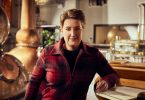“Pubs must re-excite people” – Kay McCarthy
MCCP The Planning Agency’s Kay McCarthy looks into the future for a living. She examines economic and demographic indicators and then formulates an outlook for different sectors of industry. Today, she’s looking at the licensed trade.
First, the Big Picture.
General economic situation
The indicators in the economy are positive.
“Economic growth is expected to be strong,” she opens, “It’s heartening to know that GNP is rising. It’s expected to grow by around 5% in 2014 and 2015. Unemployment is dropping back to around 11% from 12% last year. Consumer confidence is at the highest level since 2005 and it’s rising steadily.”
Correspondingly we see people with more disposable income of at least €100 at end of the month rising from 1.6 million people to 1.7 million.
And there’s been a drop in people saying their disposable income declined over the past year (54% in April 2014 vs 65% in April 2013, she points out).
“But while this means more people with that €100, in Dublin we’re also seeing house prices and rents rising by 25% and nationally (up 15%). Couple this with the introduction of water taxes and pressures on disposable income will continue.
“We’ve seen the price of alcohol rise 4.1% in the past year. All this means we’re still seeing – as of Q2 this year – 56% of Irish people cutting down on out-of-home entertainment and a further 20% who expect to continue to cut down on out-of-home entertainment when economic conditions improve.”
So even with more returning to the workforce and having a bit more income, publicans cannot assume that they’re going to rush out and spend it on out-of-home entertainment.
2015 drivers/opportunities
Pubs today compete with the ‘at-home’ spend on Netflix etc and not with the pub next door.
“It’s about working together to get people out, to re-excite them about going to the pub and the social discovery that goes with it in bars.”
People want new products and experiences really worth paying for – affordable treats that cannot be got at home or elsewhere.
“CSO data has highlighted the second major demographic area over the next five years where the number of under 24 year-olds is set to grow by 3% and 25 to 54 year-olds – the largest single group and the main bread & butter of the licensed trade – is due to decline by 4% while the number of plus-55s is due to grow by 12%.
“One must consider the economic impact this is likely to have on the country and the demographic impact of younger people having very different expectations from their predecessors,” she explains, “From the pub’s point-of-view, these young people (‘Millennials’) didn’t grow up with the pub but grew up in an era where pre-drinking was the norm.
“We know from our research that this can often be the best part of the night for Millennials who don’t fully understand the role of the pub. They go from home to nightclub so there’s a big job to be done to make pubs relevant again; publicans need to re-introduce the idea of what social value the pub can have for them, the ‘digital natives’, the Generation Y – all of them want to eat and drink in restaurants and bars, so drink has become much less important per se to them.
“If one looks at the decline of 25 to 54 year-olds, while 4% may not seem like a lot, they’re the mainstay of the pub-going public; Generation X (35+) has been compressed in the middle by pressure to support parents and kids; they’ll want more exclusive drinking experiences when out, for example high quality premium brands, consistency, food pairing etc. They’ll want to discover new brands such as craft beers which remain relatively small at present.”
People want to drink ‘less’ but of ‘higher quality’, so she predicts a growth in the higher alcohol/higher taste experience but at lower consumption levels for this 35-plus audience.
Craft beer tasting is important to today’s consumer. They expect the barman to know about the product so barstaff are no longer just about great service but must also educate the consumer about the qualities of the product and to ‘sell’ that product.
“They want the product sold in the right glass for the right experience,” believes Kay, “In tandem with this, they’re expected to sell the spirit too. Consumers want to get the full detail behind the product; they want the background and story to the brand. That’s why beer and whiskey festivals are so successful.”
55-plus market
Increasingly, the 55-plus market is becoming the most significant. It’s more likely to be an audience familiar with going to the ‘local’, but it too will want consistency of product.
“This age group is not necessarily classed as ‘old’,” she points out, “They’re able to re-discover their youth as ‘50’ is the new ‘40’.
“They’re Baby Boomers so want brands that are recognisable from a premium and quality point-of-view.
“They want to discover new product experiences from known brands, thus the demand for brand extensions and fusions with new tastes and different alcohol categories. “They’re moderate drinkers. They don’t want to drink a lot, so lighter-tasting beers that offer a quality experience will be in demand. Indeed, we might see a re-invention of what light-tasting beer means in this market.
“Younger audiences want brands that have meaning attached to them so they want fun brands that just don’t talk about themselves but stand for something ‘fun’.”
It’s a young person’s digital world
In a world where everybody’s online, people still want the human experience.
“Younger people want brands that surprise them and can entertain them online” she says, “so bars really need to get their online strategy together so that they’re not just entertaining people when in the bar but also before they get to the bar and across the week generally.”
Kay reminds me that pubs themselves are brands as they say something to the customer about ‘who I am as a customer’.
“So while pubs can’t ignore the power of digital in promoting themselves, the power of the pub for social interaction where one can meet new people in a pub rather than at home or in a restaurant needs to be pushed.
“Pubs are not only great social experiences, they offer the opportunity to discover new brands of beer, new quality experiences and new people.
“Pubs need to segment themselves so that they’re not all about one experience, one proposition.
“If we’re to truly be the social capital of the world we need to tap into that need for social interaction that pubs have always answered, but we need to address it from today’s perspective in that it’s not all about alcohol intake but rather where alcohol is a part of the ‘magic mix’ of social and people factors.”
As we know, tourism is growing in Ireland and it’s very important that we’re not just serving up the stereotype of the Irish bar. It should be a place where you can get the best drinking experience combined with the best food experience.
“And” she suggests in conclusion, “we should not just be thinking about Ireland but about the world as a reference point”.








